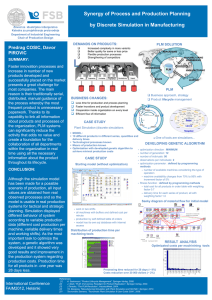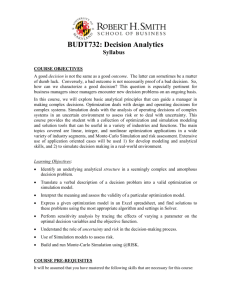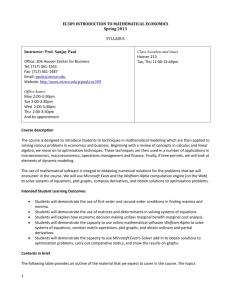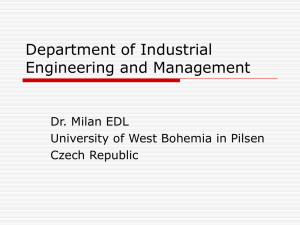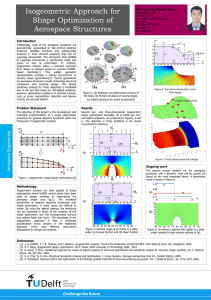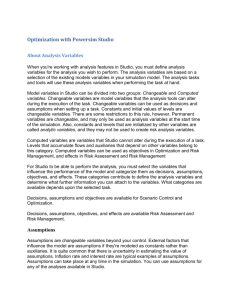SYSEN5200 Systems Architecture Course Syllabus
advertisement
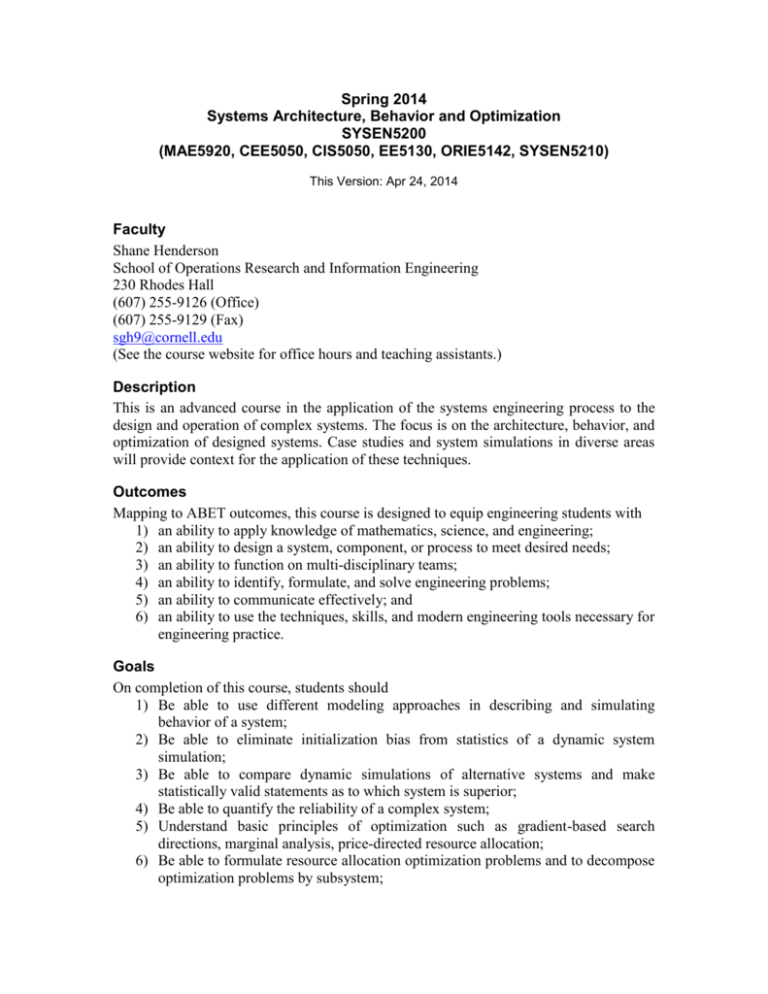
Spring 2014 Systems Architecture, Behavior and Optimization SYSEN5200 (MAE5920, CEE5050, CIS5050, EE5130, ORIE5142, SYSEN5210) This Version: Apr 24, 2014 Faculty Shane Henderson School of Operations Research and Information Engineering 230 Rhodes Hall (607) 255-9126 (Office) (607) 255-9129 (Fax) sgh9@cornell.edu (See the course website for office hours and teaching assistants.) Description This is an advanced course in the application of the systems engineering process to the design and operation of complex systems. The focus is on the architecture, behavior, and optimization of designed systems. Case studies and system simulations in diverse areas will provide context for the application of these techniques. Outcomes Mapping to ABET outcomes, this course is designed to equip engineering students with 1) an ability to apply knowledge of mathematics, science, and engineering; 2) an ability to design a system, component, or process to meet desired needs; 3) an ability to function on multi-disciplinary teams; 4) an ability to identify, formulate, and solve engineering problems; 5) an ability to communicate effectively; and 6) an ability to use the techniques, skills, and modern engineering tools necessary for engineering practice. Goals On completion of this course, students should 1) Be able to use different modeling approaches in describing and simulating behavior of a system; 2) Be able to eliminate initialization bias from statistics of a dynamic system simulation; 3) Be able to compare dynamic simulations of alternative systems and make statistically valid statements as to which system is superior; 4) Be able to quantify the reliability of a complex system; 5) Understand basic principles of optimization such as gradient-based search directions, marginal analysis, price-directed resource allocation; 6) Be able to formulate resource allocation optimization problems and to decompose optimization problems by subsystem; 7) Be able to formally structure multi-attribute decision making problems using the analytic hierarchy process and other weight and rate methods; 8) Be able to pose and solve probabilistic decision problems and compute the value of information; 9) Be able to design fault-tolerant communications networks and use optimization algorithms to route data packets with minimum delay; and 10) Be able to quantify the reliability of networked systems. Software Microsoft Excel and VisualBasic Pre-requisites On-Campus Students: Senior/graduate standing and completion of SYSEN 5100/5110 (Model Based Systems Engineering). You are expected to have background in probability and statistics at the level of ENGRD 2700 (Basic Engineering Probability and Statistics) and calculus skills. Off-Campus Students: Completion of Bachelor of Science degree with a major in some branch of engineering and SYSEN 5100/5110 (Model Based Systems Engineering). You are expected to have taken an introductory course on probability and statistics that covers probability distribution functions, cumulative distribution functions, expectations, central limit theorem and confidence intervals, and a course on vector calculus. Both: Ability to write small computer programs in some language. Text There is no required textbook for the course. The instructor will post lecture notes on a weekly basis. The material we cover is covered in a number of books. Some good references are as follows. 1) Topics related to probability and statistics: Chapters 1 and 2 from Sheldon Ross, Introduction to Probability Models. 2) Topics related to simulation: Chapters 4, 5, 6 and 7 from Sheldon Ross, Simulation. 3) Topics related to reliability analysis: Chapter 9 from Sheldon Ross, Introduction to Probability Models. 4) Topics related to optimization: Chapters 1, 6.2.1-6.2.3, 8.1, 8.6, 9.1 from Mokhtar Bazaraa, Sherali and Shetty, Nonlinear Programming - Theory and Algorithms. 5) Topics related to multi-attribute decision making, optimization under uncertainty and influence diagrams: W.L. Winston, Operations Research - Applications and Algorithms. 6) Topics related to network reliability and routing: Chapter 5 from Bertsekas and Gallager Data Networks. These books are only meant to serve as references and they provide much more detail than we cover in this class. You are not required to purchase or go through these books. However, if you find yourself interested in one of the topics, then these books should serve as a good starting point for further exploration. Homework There will be near-weekly homework assignments. The homework assignments will typically be due on Fridays. On-campus students should turn in their work in the drop box located on the second floor of Rhodes Hall. Off-campus students should use the electronic drop box on the course website. (Click on the title of the homework you wish to hand in and upload your file.) There will be no extension on homework assignments irrespective of the reason. We will drop the two lowest homework assignment grades at the end. This should provide enough flexibility. Please use these two homework assignments wisely. Grading Participation 4%, Completing the course evaluation 1%, Homework 20%, Exams (collectively) 55%, Final Project 20%. Your exam grade is the maximum of (25% Prelim and 30% final, 55% final), which benefits those who improve over the semester without disadvantaging anyone. There will be occasional small problems/quizzes in class throughout the semester. Your participation grade will partly be based on the answers that you turn in for these problems. For the homework you will be allowed to work in pairs. If you work with a partner for homework, then turn in a single homework with both your names on it, and each of you will receive the same grade. You may change homework partners as frequently as you wish. To request a regrade (within one week of the homework being returned) contact Kenneth Chong. If you are a DL student, then the weight of participation will be evenly distributed on the other items and there will be no participation portion for your grade. Policy on Academic Conduct Every student is expected to abide by the Cornell University Code of Academic Integrity. In particular, everybody has to turn in his or her own work, except for the small in-class problems, the homework and the project. You may discuss the homework assignments with other students, but only at the level of a discussion in a corridor. When you are writing down or typing your homework assignment, please make sure you are by yourself or with your homework partner. Sharing computer code or spreadsheet calculations is not allowed. You cannot get help in any way from students that have completed this course in the past. We believe that homework is a learning experience, and will grade as easily as possible, as long as you put in an honest effort. If you violate this policy, you risk having your entire homework grade set to zero or even failing the course. If you have hesitations as to whether certain actions violate the policy or not, please contact the instructor beforehand and review the code of academic integrity at http://cuinfo.cornell.edu/Academic/AIC.html. Tentative Outline Week Date 1 Jan. 23 2 3 4 Jan. 28,30 Feb. 4,6 Feb. 11,13 5 6 7 8 9 Feb. 18,20 Feb. 25,27 Mar. 4,6 Mar. 11,13 Mar. 18,20 10 Mar. 25,27 11 12 13 14 15 Apr. 1,3 Apr. 8,10 Apr. 15,17 Apr. 22,24 Apr 29, May 1 May 6 16 Topics Course introduction / Review of probability and statistics Review of prob/stat, confidence and risk Decision making under uncertainty Introduction to simulation modeling / Monte Carlo simulation Discrete-event simulation Output analysis of simulation models Reliability analysis Nonlinear unconstrained optimization Nonlinear constrained optimization / Duality and decomposition Exam I March 25, 7:30pm Statler 185 (Auditorium) Spring break Optimization applications Multi-attribute decision making TBD TBD TBD Project due May 7, 12:00pm Exam II May 12, 7pm This follows the final exam schedule announced by the registrar, see http://registrar.sas.cornell.edu/Sched/EXSP.html Place will be announced at the same website

